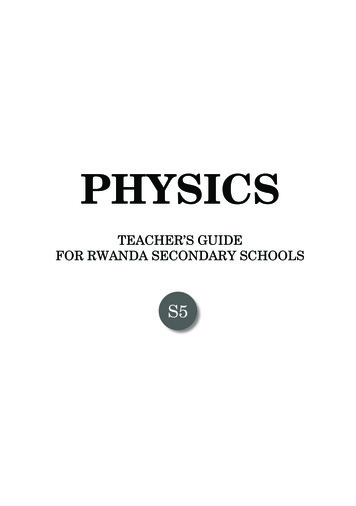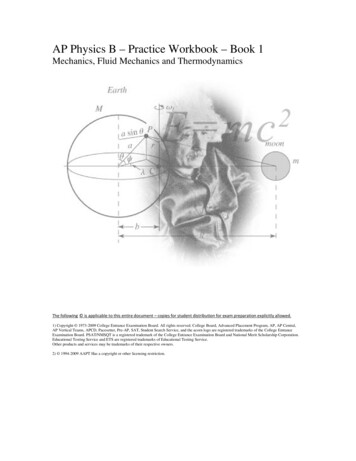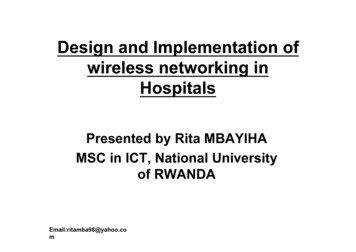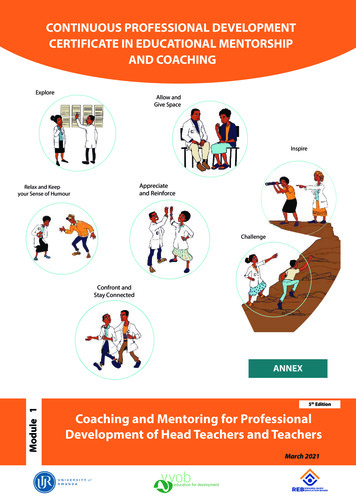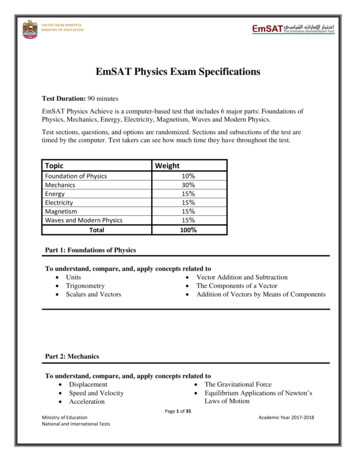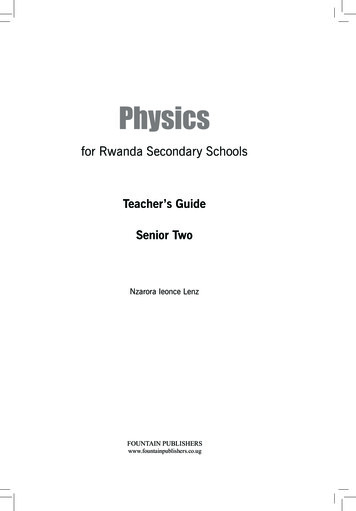
Transcription
Physicsfor Rwanda Secondary SchoolsTeacher’s GuideSenior TwoNzarora Ieonce LenzFOUNTAIN PUBLISHERSwww.fountainpublishers.co.ug
Fountain Publishers Rwanda LtdP.O. Box 6567 KigaliE-mail: ublishers.co.ugWebsite: www.fountainpublishers.co.ug Fountain publishers 2017First published 2017All rights reserved. No part of this publication may be reproduced, stored ina retrieval system, or transmitted in any form or by any means, electronic,mechanical, photocopying, recording or otherwise, without prior writtenpermission from the publishers.ISBN 978-9970-19-399-8
ContentsSection I . viii1General Introduction. ixIntroduction to the new curriculum.ixCharacteristics of competence-based curriculum . xv2Teaching Methods.xvii2.1 Teacher centered method (Traditional teaching .method). xvii2.2 Learner centered method (Active methods). xvii3Teaching-learning techniques used in developing competences. xix4Teaching-learning resources/aids. xxiv4.1 Improvisations when no lab.xxv5General Objectives. xxvi6Education approach. xxvii6.1 The outcomes approach. xxvii6.2 The Learning outcomes. xxix6.3 Learning and teaching.xxx6.4 Developing Physics skills. xxxi6.5 Learner-centered, problem-solving based approach. xxxi7Lesson Organisation. xxxvi8Assessment approach. xl8.1 Types of assessment.xl8.2 Assessing Physics units. xli8.3 Feedback. xliii9Physics overview and content map.xliv9.1 Physics overview. xliv9.2 Content Map.xlviii10.Competence – Based Lesson Plan.lxivCompetence – Based Lesson Plan. lxvi
Section II . lxxiTeaching and learning approaches for each unit. lxxiiUnit 1Sources of errors in measurement of physical quantities.11.1 Specific suggested methods/strategies/approachesof this unit.21.2 Support on assessment strategies and tasks of assessment.21.3 Lessons and timing.21.4 Solutions of unit activities.31.5 Suggested answers for unit 1 Assessment . 41.6 Additional information (content).51.7 Remedial and extension problem.7Unit 2Quantitative analysis of linear motion.92.1 Specific suggested methods/strategies/approaches ofthe unit.102.2 Support on assessment strategies and tasks of assessment.102.3 Lessons and timing.102.4 Solutions of unit activities.102.5 Suggested answers for unit 2 Assessment .132.6 Additional information (content).152.7 Remedial extension and consolidation activities.16Unit 3Friction Force.213.1 Specific suggested methods/strategies/approachesof the unit.223.2 Support on assessment strategies and tasks of assessment.223.3 Lessons and timings.223.4 Solutions of unit activities.233.5 Suggested answers for unit 3 Assessment.243.6 Additional information (content).263.7 Remedial extension and consolidation.29Unit 4Density and Pressure in Solids and Fluid.334.1 Specific suggested methods/strategies/approachesof the unit.344.2 Support on assessment strategies and tasks of assessment.344.3 Lessons and timing.344.4 Solutions of unit activities.354.5 Suggested answers for unit 4 Assessment.364.6 Additional information (content).384.7 Remedial extension and consolidation.39
Unit 5Measuring liquid Pressure with a Manometer.445.1 Specific suggested methods/strategies/approachesof the unit.455.2 Support on assessment strategies and tasks of assessment.455.3 Lessons and timing.455.4 Solutions of unit activities.465.5 Suggested answers for unit 5 Assessment. 485.6 Additional information (contents).505.7 Remedial extension and consolidation.52Unit 6Pascal’s principle and its applications.546.1 Specific suggested methods/strategies/approachesof the unit.556.2 Support on assessment strategies and tasks of assessment.556.3 Lessons and timing.556.4 Solutions of unit activities.556.5 Suggested answers for unit 6 Assessment. 566.6 Additional information (content).586.7 Remedial extension and consolidation.58Unit 7Archimedes’ principle and atmospheric pressure.607.1 Specific suggested methods/strategies/approachesof the unit.617.2 Support on assessment strategies and tasks of assessment.617.3 Lessons and timing.617.4 Solutions of unit activities.627.5 Suggested answers for unit 7 Assessment.647.6 Additional information (content).697.7 Additional remedial and consolidation problems.70Unit 8Work, Power and Energy.728.1 Specific suggested methods/strategies approachesof the unit.738.2 Support on assessment strategies and tasks of assessment.738.4 Solutions of unit activities.738.5 Suggested answers for unit 8 Assessment .768.6 Additional information (content).798.7 Remedial extension and consolidation.83Unit 9Conservation of Mechanical Energy in isolated systems.899.1 Specific suggested methods/strategies/approachesof the unit.909.2 Support on assessment strategies and tasks of assessment.90
9.39.49.59.69.7Lessons and timing.90Solutions of unit activities.90Suggested answers for unit 9 Assessment . 92Additional information (content).94Remedial, extension and consolidation activities.94Unit 10 Gas Laws’ Experiments.9610.1 Specific suggested methods/strategies/approachesof the unit.9710.2 Support on assessment strategies and tasks of assessment.9710.3 Lessons and timing.9710.4 Solutions of unit activities.9810.5 Suggested answers for unit 10 Assessment.10210.6 Additional information (content).10410.7 Remedial extension and consolidation.107Unit 11 Magnetisation and Demagnetisation.11111.1 Specific suggested methods/strategies/approachesof the unit.11211.2 Support on assessment strategies and tasks of assessment.11211.3 Lessons and timing.11211.4 Solutions of unit activities.11311.5 Suggested answers for unit 11 Assessment .11411.6 Additional information (content).11511.7 Remedial, Extension and consolidation.116Unit 12 Applications of Electrostatic.11712.1 Specific suggested methods/strategies/approachesof the unit.11813.2 Support on assessment strategies and tasks ofassessment.11812.3 Lessons and timing.11812.4 Solution of unit activities.11812.5 Suggested answers for unit 12 assessment.12112.6 Additional information (content).12512.7 Remedial extension and consolidation.126Unit 13 Arrangement of Resistors in an Electric Circuit.13013.1 Specific suggested methods/strategies/approachesof the unit.13113.2 Support on assessment strategies and tasks of assessment.13113.3 Lessons and timing.13113.4 Solutions of unit activities.132
13.5 Suggested answers for unit 13 Assessment .13513.6 Additional information (content).13913.7 Remedial extension and consolidation.140Unit 14 Reflection of Light in Curved Mirrors.14314.1 Specific suggested methods/strategies/approachesof the unit.14414.2 Support on assessment strategies and tasksof assessment.14414.3 Lessons and timing.14414.4 Solutions of unit activities.14414.5 Suggested answers for unit 14 Assessment .14514.6 Additional information (content).15014.7 Remedial extension and consolidation.151Unit 15 Basic Electronic Components.15315.1 Specific suggested methods/strategies/approachesof the unit.15415.2 Support on assessment strategies and tasksof assessment.15415.3 Lessons and timing.15415.4 Solutions of unit activities.15515.5 Suggested answers for unit 15 Assessment.15815.6 Additional information (content).16015.7 Remedial extension and consolidation.163Bibliography.166
Section Iviii
Introduction1 General IntroductionIntroduction to the new curriculumPhysics is one of the natural science subjects and contributes significantly toglobal socioeconomic transformation through its discoveries. These have led todevelopment of new technologies in all fields of production and are beneficialto mankind. Applications of Physics knowledge is evident in industries such asengineering, transport (automobiles, trains, planes, etc.), medicine and Informationand Communication Technology (ICT).Some of the discoveries based on Physics knowledge include televisions, computers,electrical appliances, and nuclear weapons advancements in thermodynamics andmechanics, which led to industrialisation.The ambition to develop a skilled-based society and the growth of regional and globalcompetition in the jobs market has necessitated the shift from knowledge based to acompetence-based curriculum in pre-primary, primary and secondary schools. Thisnew curriculum will address the issues of lack of appropriate skills that had croppedin the Rwandan education system.Competence-based curriculumA Competence is defined as the ability to use appropriate combination of knowledge,skills, attitudes and, values in order to accomplish a particular task successfully. Thatis, the ability to apply learning with confidence in a range of situations.To be competent is, for example:ᇢᇢ to be able to prepare a balanced diet rather than making a list of components ofa balanced diet only;ᇢᇢ to adopt good practices of preparing and drinking clean water rather than onlylisting the qualities of clean drinking water and;ᇢᇢ to be able to communicate fluently and accurately with others in everyday lifesituations rather than simply knowing grammatical rules and being able toproduce lists of vocabulary.A competence-based curriculum takes learning to higher levels by providingchallenging and engaging learning experiences which require deep thinking ratherthan just memorisation. This means moving beyond the recall of information toa level of sufficient understanding for learners to apply their learning in practicalsituations.ix
Physics For Rwanda Teacher’s Guide Book TwoA competence-based curriculum must address learner’s individual needs, interests,abilities and backgrounds, creating an environment where learning activities areorganised in a way that encourages learners to construct the knowledge eitherindividually or in groups in an active manner.Categories of competences in Rwandan curriculumThe priority competences for the national curriculum as identified in variouspolicy documents (Vision 2020, EDPRS 2, ESSP, 7YGP) include generic and basiccompetences. The description of each of the competences, whether generic orbasic, provides insight into the broad learning outcomes expected for each of them,emphasising their relevance for each level of education.Generic competencesGeneric competences are transferrable and applicable to a range of situationsincluding employment and it is through these competences that learners develop theirhigher order thinking and deepen their learning: Among them are Critical thinking,Creativity and innovation, Research and problem-solving, Communication, Cooperation, Interpersonal management and life skills, Lifelong learning.The table below provides generic competences and their descriptors:GenericCompetencesCompetence DescriptorsCritical thinkingᇢᇢ Think reflectively, broadly and logically aboutchallenges encountered in all situations.ᇢᇢ Weigh up evidence and make appropriate decisionsbased on experience and relevant learning.ᇢᇢ Think imaginatively and evaluate ideas in ameaningful way before arriving at a conclusion.ᇢᇢ Explore and evaluate alternative explanations tothose presented by others.x
IntroductionCreativity andinnovationᇢᇢ Responding creatively to different challengesencountered in life.ᇢᇢ Use imagination beyond knowledge provided togenerate new ideas to enrich learning.ᇢᇢ Take the initiative to explore challenges and ideasin order to construct new concepts.ᇢᇢ Generate original ideas and apply them in learningsituations.ᇢᇢ Demonstrate resilience when faced with learningchallenges.Research andproblem solvingᇢᇢ Be resourceful in finding answers to questions andsolutions to problems.ᇢᇢ Produce new knowledge based on research ofexisting information and concepts and soundjudgment in developing viable solutions.ᇢᇢ Explain phenomena based on findings frominformation gathered or provided.Communicationᇢᇢ Communicating and conveying confidently andeffectively information and ideas, through speakingand writing and other forms of communication,using correct language structures and relevantvocabulary in a range of social and culturalcontexts.ᇢᇢ Comprehending language through listening andreading.ᇢᇢ Using oral and written language to discuss, argueand debate a variety of themes in a logical andappealing manner.ᇢᇢ Communicate clearly and confidently using arange of linguistic, symbolic, representational andphysical expression.ᇢᇢ Developing and communicating formal messagesand speech appropriate to the target recipient oraudience.xi
Physics For Rwanda Teacher’s Guide Book TwoCooperation,interpersonalmanagement, lifeskillsᇢᇢ Co-operating with others as a team in whatever taskassigned.ᇢᇢ Adapting to different situations including the worldof work.ᇢᇢ Demonstrating a sense of personal and socialresponsibility and making ethical decisions andjudgments.ᇢᇢ Respect others’ rights, views and feelings.ᇢᇢ Having positive ethical and moral attitudes withsocially acceptable behaviour.ᇢᇢ Perform practical activities related to environmentalconservation and protection.ᇢᇢ Advocating for personal, family and communityhealth, hygiene and nutrition.ᇢᇢ Developing motor skills to perform a variety ofphysical activities for fitness, health, leisure andsocial interaction.Lifelong learningᇢᇢ Taking the initiative to update knowledge and skillswith minimum external support.ᇢᇢ Coping with the evolution of knowledge andtechnology advances for personal fulfilment.ᇢᇢ Seeking out acquaintances more knowledgeablein areas that need personal improvement anddevelopment.ᇢᇢ Exploiting all opportunities available to improve onknowledge and skills.Table 1.1: Generic competence descriptorsBasic competencesThese are keys and essential competences highlighted in national policy documents.Their descriptors give an orientation about priority subjects to be taught, and thekind of learner envisaged at the end of every cycle, these are: Literacy, numeracy,xii
IntroductionICT, Citizenship and national identity, entrepreneurship and business development,science and technology.The table below provides basic competences and their descriptors:Basic competencesDescriptors: What learners are able to demonstrateduring the learning processLiteracyᇢᇢ Reading a variety of texts accurately and fast.ᇢᇢ Expressing ideas, messages and events throughwriting legible texts in good hand-writing withcorrectly spelt words.ᇢᇢ Communicating ideas effectively through speakingusing correct phonetics of words.ᇢᇢ Listening carefully for understanding and seekingclarification when necessary.Numeracyᇢᇢ Computing accurately using the four mathematicaloperations.ᇢᇢ Manipulating numbers, mathematical symbols,quantities, shapes and figures to accomplish a taskinvolving calculations, measurements and estimations.ᇢᇢ Use numerical patterns and relations to solveproblems related to everyday activities likecommercial context and financial management.ᇢᇢ Interpreting basic statistical data using tables,diagrams, charts and graphs.ICT and digitalcompetencesᇢᇢ Locating, extracting, recording and interpretinginformation from various sources.ᇢᇢ Assessing, retrieving and exchanging information viainternet or cell phones.ᇢᇢ Using cell phones and internet for leisure and formoney transactions.ᇢᇢ Using computer keyboard and mouse to write andstore information.ᇢᇢ Using information and communication technologiesto enhance learning.xiii
Physics For Rwanda Teacher’s Guide Book TwoCitizenship andnational identityᇢᇢ Relating the impact of historical events on past andpresent national and cultural identity.ᇢᇢ Understanding the historical and cultural roots ofRwandan society and how the local super structurefunctions in relation to the global environment.ᇢᇢ Demonstrating respect for cultural identities andexpressing the role of the national language in socialand cultural context.ᇢᇢ Advocating for the historical, cultural andgeographical heritage of the nation within the globaldimensions.ᇢᇢ Showing national awareness, a strong sense ofbelonging and patriotism.ᇢᇢ Advocating for a harmonious and cohesive societyand working with people from diverse culturalbackgrounds.Entrepreneurshipand businessdevelopmentᇢᇢ Applying entrepreneurial attitudes and approaches tochallenges and opportunities in school and in life.ᇢᇢ Understanding obligations of parties involved inemployment.ᇢᇢ Planning and managing micro projects and small andmedium enterprises.ᇢᇢ Creation of employment and keeping proper books ofaccounts.ᇢᇢ Taking risks in business ventures and in otherinitiatives.ᇢᇢ Evaluating resources needed for a business.Science andtechnologyᇢᇢ Applying science and technology skills to solvepractical problems encountered in everyday lifeincluding efficient and effective performance of agiven task.ᇢᇢ Develop a sense of curiosity, inquisitiveness andresearch to explain theories, hypotheses and naturalphenomena.ᇢᇢ Reasoning deductively and inductively in a logicalmanner.ᇢᇢ Using and experimenting with a range of objectsand tools of science and technology and drawingappropriate conclusions.Table1.2: Basic competence descriptorsxiv
IntroductionCharacteristics of competence-based curriculumCompetence-based approachThis is an approach where teaching and learning is based on discrete skills ratherthan dwelling on only knowledge or cognitive domain of learning. Learners workon competences through units with specific learning outcomes broken down intoknowledge, skills and attitude. The learner is evaluated against a set of standards toachieve before moving on. The learning activities are learner centered rather than thetraditional didactic approach.InclusiveThe curriculum ensures that every individual is valued and there are high expectationsof every learner. Learning is organised so that all learners thrive, including girls,learners with disabilities, learners with special educational needs and regardless oftheir background.Interconnected and crosscutting issuesThe competence-based curriculum reflects the significance of connections betweendifferent subject areas, integrating them across years and cycles where applicable.Crosscutting issues are integrated across learning areas appropriately. They are allimportant for learners to learn about, but they are not confined to one subject. Crosscutting issues are not stand alone subjects. They are issues which cut across theentyre curriculum.There are eight (8) crosscutting issues:1.Peace and values education2.Genocide studies3.Gender education4.Inclusive education5.Comprehensive sexuality education6.Financial education7.Environment and sustainability8.Standardisation culturexv
Physics For Rwanda Teacher’s Guide Book TwoFlexibleThis caters for learner’s individual needs and talents and ensure provision of aholistic education that include knowledge, skills, attitude and values and facilitateshorizontal and vertical mobility within and across different education systems.This curriculum allows interactive teaching and learning involving all categories oflearners to provide opportunities to nurture them.Transparent and accountableSchools, learners and communities must communicate openly and honestly aboutthe curriculum and learning in the school, to ensure successful teaching and learning.Parents and teachers and senior management staff in schools must be engagedtogether in supporting teaching and learning and holding each accountable for theircontributions. School management must be open to stakeholders and policy makersto support efficient administration and effective teaching.In competence based curriculum, learners will now get the opportunity to apply whatthey have learned in real life situations and to make a difference in their own lifewith the help of the teacher whose role is central to the success of the curriculumdelivery.This teacher’s guide gives practical ideas about ways of implementing the Physicssyllabus: suggestions about what to teach, strategies for facilitating learning andteaching, how to assess and suggested assessment tasks.A variety of suggested learning and teaching activities provides teachers withideas to motivate learners to learn, and make learning relevant, interesting andenjoyable. Teachers should relate learning Physics to real issues and the localenvironment. Teaching using meaningful contexts and making sure that learnersparticipate in appropriate practical activities, assisting learners to gain knowledgeand understanding, and demonstrate skills in Physics.Teachers are encouraged to integrate Physics activities with other subjects, whereappropriate, so that learners can see the interrelationships between subjects and thatthe course they are studying provides a holistic education and a pathway for thefuture.xvi
Introduction2 Teaching Methods2.1Teacher centered method (Traditional teachingmethod)Teachers are not required to teach the way they were taught. They must embracethe new approaches with the aim of developing competences in the learners. Thisrequires them to shift from teacher-centered to learner-centered methods.The teacher centered method is characterised by the teacher’s central position. She/he/she is the controller of the learning environment, has the power and responsibilityand he plays the role of instructor and decision maker (in regards to curriculumcontent and specific outcomes).Characteristics of the teacher centered method:ᇢᇢ It is the teacher that causes learning to occur.ᇢᇢ By this method, knowledge is imposed on the learner without considering herhis psychological level, interests and tendencies.ᇢᇢ It is the school where the teacher talks and learners listen passively.The traditional teaching method is accused of the following:ᇢᇢ The teacher talks too much and neglects the learner.ᇢᇢ The learner is passive and does not participate actively in the teaching/learningprocess.ᇢᇢ It doesn’t allow learners to share their knowledge and experience.ᇢᇢ It is boring.ᇢᇢ It doesn’t allow learners to achieve major psychomotor or cognitive objectives.2.2Learner centered method (Active methods)Educators commonly use three phrases (Learner-centered/learning-centeredteaching or learner-centered learning) with this approach. Learner- centeredteaching places the emphasis on the person who is doing the learning (Weimer,2002). Learning-centered teaching focuses on the process of learning.xvii
Physics For Rwanda Teacher’s Guide Book TwoCharacteristics of the learner centered method:ᇢᇢ The learner centered method is that type which lays emphasis on the learner asthe center of all activities in the learning process.ᇢᇢ The learner is actively involved and sequencing of the learning experiences isbased on the principle of experience and activity.ᇢᇢ According to the early educators like John Dewey, Rousseau, Montessori, JohnDewey, Carapared, . a child is free to exercise his freedom.ᇢᇢ The school therefore considers the needs of individual learners, interests,background etc.Should or can all course be learner-centered? Being a learner-centered instructorshould be your goal, but it is not necessary or practical to be learner-centered onevery component. Instructors should not expect their courses ever to be at the higheststandard in all categories with every component.Distinctions between learner-centered method and teacher-centeredmethodTeacher- centered methodLearner-centered methodLearners are often passive (No role inplanning learning; apart from sitting
Physics is one of the natural science subjects and contributes significantly to global socioeconomic transformation through its discoveries. These have led to development of new technologies in all fields of production and are beneficial to mankind. Applications of Ph

